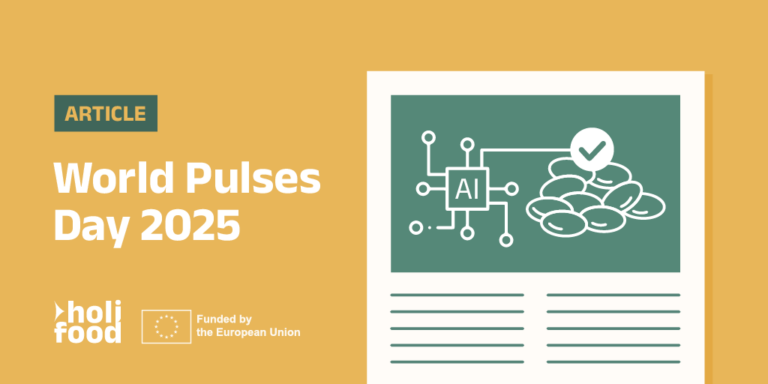How AI and policy innovation secure our lentils for better food safety

Each year on February 10th, the United Nations (UN) celebrates World Pulses Day, a global event designed to highlight the global importance of pulses in sustainable food systems. The United Nations states that the cultivation of pulses is an effective strategy to contribute to achieving its 2030 Agenda for Sustainable Development, as they can help in creating sustainable food systems and eliminating global hunger and poverty. Among these crops, lentils emerge as a particularly promising pulse, providing both nutritional advantages and sustainable protein alternatives.
The HOLiFOOD project’s focus on lentil safety aligns with the World Pulses Day’s mission to promote more efficient, inclusive, and sustainable agrifood systems. The project is currently working on developing new methodologies for assessing and managing food safety in lentil production and consumption across Europe. This project covers two key areas, among others: the development of Artificial Intelligence (AI)-driven food safety identification tools and the creation of evidence-based policy frameworks to support decision-making in food safety management of the lentils supply chain.
Lentils and AI-Driven Food Safety methods
One essential part of the HOLiFOOD project is the use of AI for a comprehensive and early identification of food safety hazards.
HOLiFOOD’s researchers have developed AI methods focused on lentils, using machine learning and deep learning to estimate the probability of the presence of pesticide residues in lentils. The estimations can be used to guide risk based sampling and analyses.
Nonetheless, one drawback of AI methods could be that their inner workings can be complex to interpret by the user; in general, understanding how these methods arrive at their conclusions requires specialised analytical approaches. As a result, these AI methods are often referred to as a “black box”.
As part of HOLiFOOD’s holistic approach, the project intends to highlight this black box through using “explainable AI”, diving ‘beneath the surface’ of the AI algorithm to understand its inner workings. The AI methods demonstrate effective collaboration among researchers in the project, both in terms of identifying those drivers of change and in the publication process of their findings.
HOLiFOOD’s researchers are aiming to publish the results of our holistic explainable AI pesticide estimation method for lentils in 2025.
Lentils’ economic and health policy implications
Another important consideration regarding lentils is minimizing food risks and integrated risk management in Europe.
One objective is to comprehensively assess possible actions for mitigating food risks, both now and in the future, under climate change conditions. The purpose is to establish whether additional policy measures should be supported at the European level.
A methodology combining quantitative health impact assessment and cost‒benefit analysis has been developed to support food policy decisions regarding “When to intervene?” and “How to intervene?”.
The project has applied this framework to the lentil market, demonstrating the approach’s usefulness and ability to simplify regulatory measures.
The findings assess the health consequences and welfare changes associated with potential dietary changes, including the influence of regulatory interventions such as subsidies and taxes.
From a health economics perspective, the framework:
- provides a starting point for interdisciplinary discussions on the holistic assessment of food systems
- encourages directing risk management strategies associated with fiscal policies
Overall, findings indicated that an increase in lentil consumption in France was beneficial, however more information will be released soon.
Researchers plan to include the environmental impacts in our assessment and examine several scenarios using 2050 projections, driven by factors such as climate change and rising lentil consumption in Europe (via imports or increased production inside Europe).
Conclusion
The ongoing HOLiFOOD project’s research on lentil safety demonstrates the value of integrating technological tools with policy frameworks in food safety management.
As the food sector faces evolving challenges from climate change and increasing global demand, the methodologies developed through this project provide practical approaches for enhancing food safety measures. The findings from our lentil case study might illustrate how holistic assessment methods can effectively address complex food safety challenges while supporting evidence-based policy decisions.
About the HOLiFOOD porject
What? A 4-year project (2022-2026) funded by the European Commission under the Horizon Europe Programme that aims to introduce an holistic approach for tackling food systems risks in a changing global environment.
About the HOLiFOOD project
How? The project aims to improve the integrated food safety risk analysis (RA) framework in Europe to support the early identification of food safety risks in the food chain for a safe and sustainable food system.



